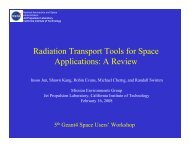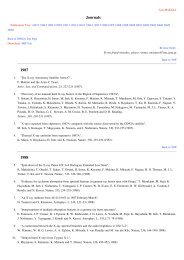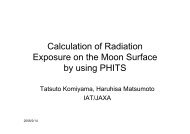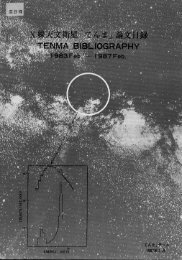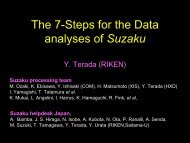2006-34: The X-ray Telescope onboard Suzaku - HEASARC - NASA
2006-34: The X-ray Telescope onboard Suzaku - HEASARC - NASA
2006-34: The X-ray Telescope onboard Suzaku - HEASARC - NASA
You also want an ePaper? Increase the reach of your titles
YUMPU automatically turns print PDFs into web optimized ePapers that Google loves.
Table 4. Best-fit parameters of the contemporaneous power-law fit to the Crab spectra taken in 2005 September 15-16.Sensor ID N HaPhoton Index Normalization b Flux c χ 2 ν (d.o.f.)XIS-default positionXIS0 0.33±0.01 2.09±0.01 9.93±0.13 2.17 1.22 (817)XIS1 — d — d 9.89±0.13 2.16XIS2 — d — d 10.04±0.13 2.19XIS3 — d — d 9.52±0.13 2.08average 9.845 2.15HXD-default positionXIS0 0.32±0.01 2.09±0.01 9.22 +0.15−0.14 2.00 1.27 (692)XIS1 — d — d 9.09±0.14 1.98XIS2 — d — d 9.77±0.15 2.13XIS3 — d — d 9.65±0.15 2.10average 9.433 2.05a Hydrogen column density in a unit of 10 22 cm −2 .b Power-law normalization in a unit of photons cm −2 s −1 keV −1 at 1 keV.c Energy flux in a unit of 10 −8 cm −2 s −1 in the 2–10keV band.d Constrained to be the same as the corresponding parameter of XIS0.to be a power law with N H = 0.33 × 10 22 cm −2 , photon index = 2.09, and the normalization =9.845 photons cm −2 s −1 keV −1 at 1 keV. <strong>The</strong>se values are the averages of the four detectors atthe XIS-default position (table 4). We then calculate the counting rate of the Crab Nebula onthe entire CCD field of view in every 0. ′ 5 step both in the Det-X and Det-Y directions using the<strong>ray</strong>-tracing simulator. Note that the abrupt drop of the model curves at ∼8 ′ is due to the sourceapproaching the detector edge. On the other hand, the data points provide the real countingrates in the corresponding energy bands within an aperture of 13. ′ 3 by 17. ′ 8. <strong>The</strong>y consist of theobservations at the five different off-axis angles 0 ′ , ±3. ′ 5, and ±7. ′ 0 both in Det-X and Det-Ydirections, where the origin is the XIS-default position (§3.1). Note that the aperture adoptedfor the observed data can collect more than 99% of the photons from the Crab Nebula, andhence the difference of the integration regions between the simulation and the observation doesnot matter. Finally, we renormalize both the simulation curve and the data so that the countingrate of the simulation curve at the origin becomes equal to unity. <strong>The</strong>se figures roughly showthat the effective area is calibrated to within ∼10% over the XIS field of view. We expect mostof these deviations can be attributed to scattering of the optical axis orientations of the fourquadrants within a telescope.3.4. Angular ResolutionVerification of the imaging capability of the XRTs has been made with the data of SS Cygin quiescence taken during 2005 November 2 01:02UT–23:39UT. <strong>The</strong> total exposure time was17



